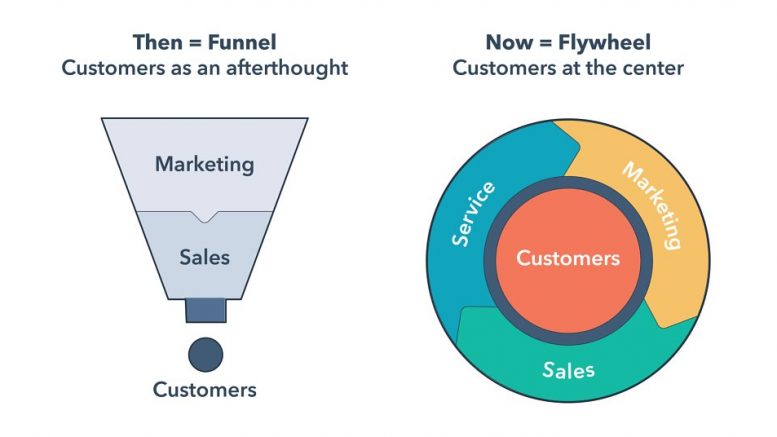I’m going to start by saying something I’ve already mentioned multiple times — because it’s just that important. Customers don’t want to be ‘sold to’. They want to be ‘connected with’. This is arguably the core reason marketing funnels have lost their sheen over the years; after all, a funnel starts with marketing and ends with closing deals, placing customers last.
Enter — the flywheel. The model was recently developed by Hubspot to address the gaps left by the funnel, and was brought on thanks to the increasing importance of customer centricity and satisfaction. The flywheel takes a cyclical approach to marketing, as opposed to the funnel’s linear model. The most essential aspect? The flywheel places the customer at its center, signifying that marketing doesn’t end as soon as a sale is made — it reinforces the notion of continued customer delight to build brand loyalty, which in turn, brings in repeat business.
Now, let’s take a look at the steps brands must take to leverage this flywheel and bring in (and keep) customers:
- Do the grunt work
It goes without saying that laying a strong, well-researched foundation is key to your success. Ask yourself: What goals do you want to achieve that you weren’t able to achieve with a traditional marketing approach? Your answer should be SMART (Specific, Measurable, Attainable, Relevant, Timely). For e.g. a medical manufacturing company may want to increase its sales by 10% in the next six months. A restaurant might want to bring in 100 new customers in the next six months. Those are SMART goals. Once you have the answer, move to aspects such as identifying personas, positioning, and budgeting.
- Create your flywheel
This one’s actually fairly simple. Every business is different, be it in terms of product, model, or targets. Based on these unique aspects, create a flywheel by identifying which teams of your organisation impact your business the most. These will become your points of force to drive each stage of the wheel — the basic ones being attract, engage, and delight.
- Study your current situation
- Before you begin work on what you need to do, understand what you’re already doing. Answer the following questions:
- What ‘attract/engage/delight’ elements do you already have in place
- What channels and tactics are producing the best leads?
- What are your conversion rates from one stage to the next?
This will help you identify additional inbound activities needed to achieve your goal (e.g. emails, blogs, brochures).
- Prioritise your action items
The issue here is, you may have identified X number of activities you need to do — but the truth is, you can’t do all of them at once. So this is the time you prioritise according to importance. Let me explain this with an example — say your action items include ramping up your customer service capabilities and initiating upgrades in your product. What should you do first? You guessed it. The upgrades. This might solve the issues the customer was having in the first place, and then you can tick off your customer service action item as well! Prioritising is thus key to streamlining this process.
- Make the most of automation tools
It’s time to get things going — and to do this, I’d recommend automating as much of the process as you can. For example, a popular marketing automation software sets up workflows that automatically email leads based on specific behaviors. If a lead downloads a certain eBook, it sends a followup email in three days inviting him/her to read a related article. Things like this will make rolling out collaterals simpler, and your flywheel better.
Now that I’ve taken you through the basic steps, let’s end with an example of a brand that adopted the flywheel and ran with it. In the e-commerce behemoth’s ‘virtuous cycle’, each core initiative is focused on customer experience. For example, bringing in more sellers lowers cost and gives more choice to customers. Lower price and more choice will also bring in new customers, and the cycle will continue! One look at the brand’s annual revenue, and you’ll know how well this is working for them!
That’s all the convincing you should need, really! You have everything you need to get started on your marketing flywheel — so jump right in and ride the wave of benefits for years to come.
The views and opinions published here belong to the author and do not necessarily reflect the views and opinions of the publisher.



Be the first to comment on "Leveraging the flywheel for effective inbound marketing"